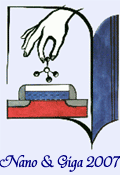
From Atoms to Materials to Devices to System Architecture
Symposium and Spring School (Tutorial Lectures)
Phoenix, Arizona, March 12-16, 2007

 |
Nano and Giga Challenges in Electronics and Photonics From Atoms to Materials to Devices to System Architecture Symposium and Spring School (Tutorial Lectures) Phoenix, Arizona, March 12-16, 2007 |
 |
|
|
Commentary
The recent development of nanotechnology enables us to manipulate very small quantities, which are difficult or even impossible to control using conventional tools. Nowadays, even single electrons and spins in semiconductor nanostructures can be controlled and manipulated at nanoscale. These manipulations are a first but a large step toward information processing using the laws of quantum mechanics - quantum computing. New paradigms in metrology have also become available. Single electron counting steers toward development of the revolutionary current measurement technique with detection limit less than atto-ampere. Single spin detection provides an invaluable insight into spin physics, and successful detection of nuclear spin polarization in nanoscale system leads to the future nano ESR and NMR on a chip – new tools for the design and characterization of nanodevices. Fundamental research is critical for future Si nanoelectronics development beyond the end of the CMOS roadmap, in particular in atomic scale interface design and spin manipulation. The frontiers of nano science and technology and tool development provide challenges, incentives and solutions to each other. For example, single electron manipulation and detection require high-speed pulse and low-noise circuit technologies in addition to sophisticated nanostructures. Much of the fundamental research needs cutting edge crystal growth and nanofabrication technologies, which are difficult in academia. On the other hand, for the success of industry, understanding the background physics is essential in spite of the fact that it is not connected to tomorrow’s business. Therefore, naturally, collaborations between academia and industry are important. Collaboration between different fields, different technologies and different societies are key issues for the future success of nanotechnology. The forthcoming meeting Nano and Giga Forum in Arizona gives us a good opportunity. The conference will cover a wide range of nanotechnologies, from fundamental sciences to their applications. This excellent forum attracts top researchers from industry as well as academia from all over the world, including Japan. We will have fruitful discussions on future collaborations at the Arizona conference. |